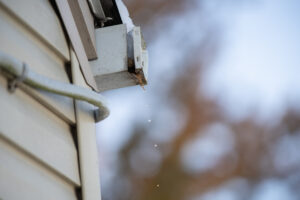The downspout’s purpose
The downspout’s job is simple: it properly channels water from the roofline and gutters away from a home’s exterior. This is either through a splash block or an extension that leads it into the street or garden. Without it, the water pools around your home’s foundation which can damage both the outside and inside.
However, the downspout’s job can get complicated. For instance, it won’t deliver runoff to the proper locations if the gutters get clogged. Furthermore, if the clog reaches the spout, then pressure builds at the point where the water accumulates. Soon enough, the pressure will break the downspout apart and result in damage to the gutters and your home.
Maintaining your downspouts
Protecting your downspout involves three steps.
- First, make sure the downspout and your gutters are free of debris.
- Second, ensure that the downspout is securely attached to your home’s exterior. Excessive runoff causes it to significantly shift if the downspout becomes loose, and enough shift causes the downspout to collapse. Tightening it on a regular basis prevents this.
- And third, consider adding another one to your home.
The necessity of another downspout
Adding a second, third, or fourth downspout to your home minimizes the risk of overflow if there’s a clog in the main tributary or in one of the gutter channels. Furthermore, an increased number of downspouts helps to distribute water during heavy rains.
A common guideline is that you need one downspout per 40’ span of gutter for proper drainage, but this is usually not enough for a 2”x3” downspout. A homeowner should also consider the size of the roof which will factor into how much water is going into the gutter.
In addition, you must focus on all spans, including those above the roofline. Second and third stories, as well as dormers, will have their own gutters and downspouts to handle runoff. To protect the roof’s surface, the downspouts should run directly into the first-story gutters. This increased volume of water needs additional avenues of output.
Downspouts on large gutters
If you decide to install bigger gutters on your home, you will need to accommodate the additional flow with additional downspouts. The average gutter width is five inches which holds approximately 1.2 gallons of water per foot. Installing gutters that are one-inch wider increases holding capacity to two gallons per foot.
If your downspout measures 2” by 3” it can have a hard time handling the increased volume. Adding another downspout can evenly distribute the water to avoid risk of failure.
Getting the most out of additional gutters
The purchase and installation of more downspouts is not insignificant, so you want to maximize their use. For instance, use one downspout to collect rain for irrigation during dry spells. Use another downspout to distribute water across your yard or garden when it does rain. Or, have the bottom end of the downspout flow into a man-made pond. In other words, don’t waste the water.
To help you determine the proper number of downspouts your home needs, contact our K-Guard Leaf Free Gutter Guard System specialists. We can measure your existing gutter spans and determine how many spouts are required in either your current setup or with our Leaf Free Gutter Guard System. Otherwise, if you would like to learn more, check out our gutter guide for new homeowners or any of our other blog posts that may help answer some of your questions.





